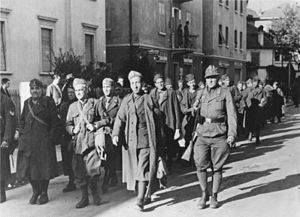Operation Achse
| Operation Achse | |||||||
|---|---|---|---|---|---|---|---|
| Part of the Italian Campaign of World War II | |||||||
 Disarmed Italian soldiers marching to captivity in Bolzano. |
|||||||
|
|||||||
| Belligerents | |||||||
|
|
|
||||||
| Commanders and leaders | |||||||
|
|
|
||||||
| Strength | |||||||
| 60 divisions (26 in Italy, 31 in the Balkans, 3 in France) | 40 divisions (17 in Italy, 19 in the Balkans, 4 in France) | ||||||
| Casualties and losses | |||||||
| 20,000–30,000 killed 800,000 prisoners 5 midget submarines captured by Romanians, many more warships captured by the Germans |
Unknown | ||||||
Operation Achse (German: Fall Achse, "Case Axis"), originally called Operation Alaric (German: Unternehmen Alarich), was the codename for the German plan to forcibly disarm the Italian armed forces after the armistice with the Allied forces in 1943. Several German divisions had entered Italy after the fall of Benito Mussolini in July 1943, while Italy was officially still an ally of Germany, despite the protests of the new Italian government under Pietro Badoglio.
The Armistice of Cassibile was made public on 8 September. German forces moved rapidly to take over the Italian zones of occupation in the Balkans and southern France, and to disarm Italian forces in Italy. In some cases, the Italian troops resisted the Germans, most notably in the Greek island of Cephalonia, where over 5,100 men of the 33rd Acqui Division were massacred after running out of ammunition and surrendering; in Rome, after the royal family and the government had fled, a disorganized defense by the Italian troops stationed around the capital was unable to defeat the German attack. Additionally, individual soldiers or whole units, like the 24th Pinerolo Division in Thessaly, went over to the local resistance movements. Only in Sardinia, Corsica, Calabria and in the southern part of Apulia were Italian troops able to offer successful resistance and hold off the Germans until relieved by the arrival of Allied forces.
...
Wikipedia
